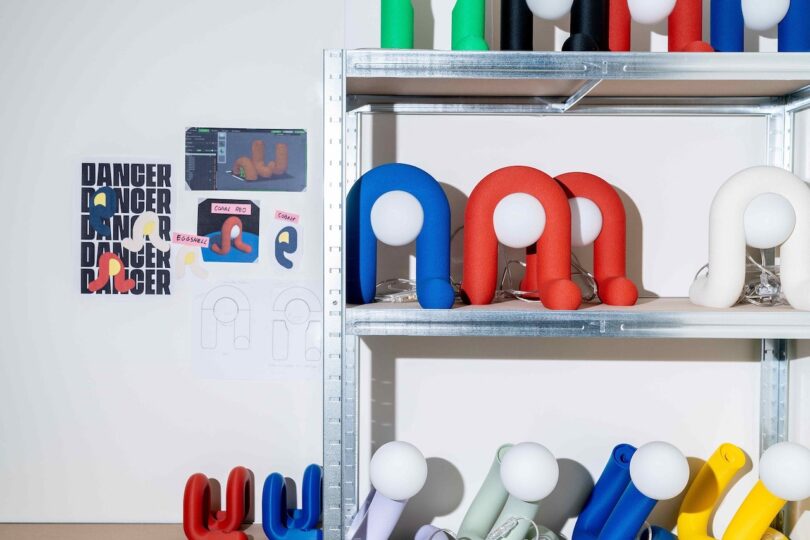
DESIGN-MILK.COM
These Playful 3D-Printed Lamps Take Sustainability Seriously
In an industry that produces stunning yet sometimes austere designs, it is refreshing to discover work that doesnt take itself too seriously. Simultaneously, it is inspiring to see that the designers behind the work are very serious about their craft. Emil Robbrecht, a Ghent-based designer, is one such creative force. His commitment to sustainability drives him to use eco-friendly materials alongside cutting-edge 3D-printing technology, all while infusing his designs with a playful touch.DancerRobbrechts latest creations, the Dancer and Big Boa lamps, are a testament to his whimsical approach. Though modest in size, these lamps give main character energy, commanding attention with their unique and striking forms. Despite their playful appearance the lamps represent serious craftsmanship a culmination of Robbrechts three years of experience honing his skills and exploring the possibilities of sustainable design.Big BoaBoth lamps feature a simple orb-like light source, but their 3D-printed forms set them apart. The Dancer, with its sculptural feet, seems poised to break into dance at any moment. Meanwhile, Big Boa, true to its reptilian namesake, appears ready to slither away, with the light source clearly representing the head. Both are 3D printed using recycled plant-based plastic from food packaging waste and are made to order in Robbrechts home studio.To get to know Robbrecht and his lamps a little better, we chatted with him below:Your designs, like the Dancer and Big Boa lamps, blend playfulness with serious craftsmanship. How do you strike the balance between whimsy and functionality in your creations? What comes first?When I have a design idea in mind, Im quite determined not to compromise aesthetics for the sake of functionality. For instance, with the Dancer lamp, the glass globe appears to be trapped within the structure, which required the lamp to be made in three separate parts to allow for bulb replacement. After numerous iterations, I managed to make the seam nearly invisible by using a snap-fit joint as the connecting mechanism. This not only enhances the overall design but also raises intriguing questions about how the lamp was made.By prioritizing aesthetics, I believe it offers customers a unique experience in how they interact with the lamps. The way the lamp is positioned also allows it to look different from every angle, which I think the photographers have captured beautifully.My first lamp design, Big Boa, taught me a great deal about the technical aspects of lamp design, which allowed me to focus more on bringing originality and complexity to the Dancer lamp. With the Dancer lamp, I aimed to create an object that raises questions about its construction both in terms of materials, as its hard to tell its 3D printed, and functionality, as people wonder how the glass shade got in there. I think this curiosity is one of the reasons why the Dancer lamp resonates with a broader audience and has gained attention.I enjoy the interplay between the glass globe and the 3D-printed components, and Im currently in the early stages of developing a new, larger design. I hope the new piece will be ready to exhibit at the For the Now design event in November.Sustainability is clearly important in your work, as seen in your use of recycled plant-based plastics. Have you found any challenges when working with sustainable materials?As 3D-printing technology evolves, I believe the availability of recycled filaments will continue to expand, making it easier for designers to opt for environmentally-friendly options. Sustainability is a core value in my daily life, so it feels natural to incorporate it into my studio practice. Like many young designers, Im increasingly conscious of the materials I use and the methods I employ in creating my work.Moreover, the two lamps Ive designed are built with easy disassembly in mind, allowing the recycled plant-based plastic, electrical components, and glass shade to be separated and recycled at the end of the lamps life cycle. This approach not only extends the lifespan of the materials but also promotes responsible disposal, minimizing environmental impact.Currently, Ive been experimenting with a variety of eco-friendly materials, including woodworking, paper pulp made from newspapers and cardboard for furniture, and 3D printing. So far, I havent encountered many challenges in sourcing or working with these sustainable materials, aside from the long drying time of paper pulp.As I continue to grow in my practice, Im looking forward to exploring different materials and processes in the future.Your pieces are made to order in your home studio. Can you share more about your studio setup and the process involved with making each piece?My design process is pretty personal I often find inspiration from whats missing in my own home, tackling one corner at a time. Right now, my home studio works well, but its getting a bit tight, so Im considering renting a bigger space where I can also experiment with furniture.If I have to sacrifice playfulness for functionality, Id rather abandon the project altogether and focus on designs where the playful aspect has full freedom. However, its not an immediate abandonment I prefer to let the project rest while I think of possible solutions. Ive noticed that my initial prototypes often dont differ much from the final result, at least from an aesthetic point of view.Although my pieces are still made-to-order, Im transitioning to small batch production due to increased demand. By pre-assembling a small batch ahead, I can focus more on future projects. I believe this approach can remain sustainable, as any slight overproduction can be managed by finding creative ways to increase demand.To add Dancer or Big Boa (or both!) to your own home collection, visit emilrobbrecht.com.
0 Commentarios
0 Acciones
22 Views


